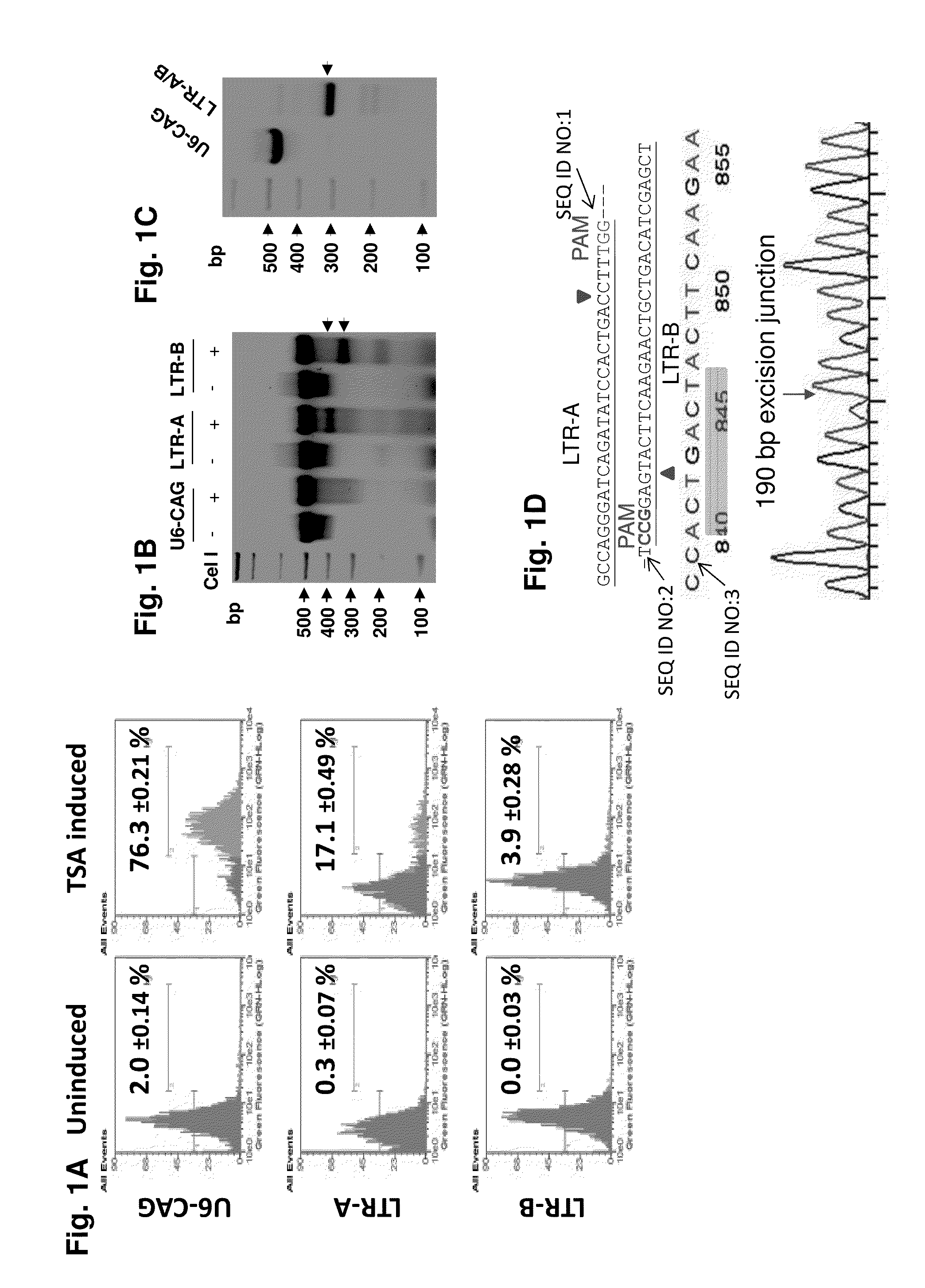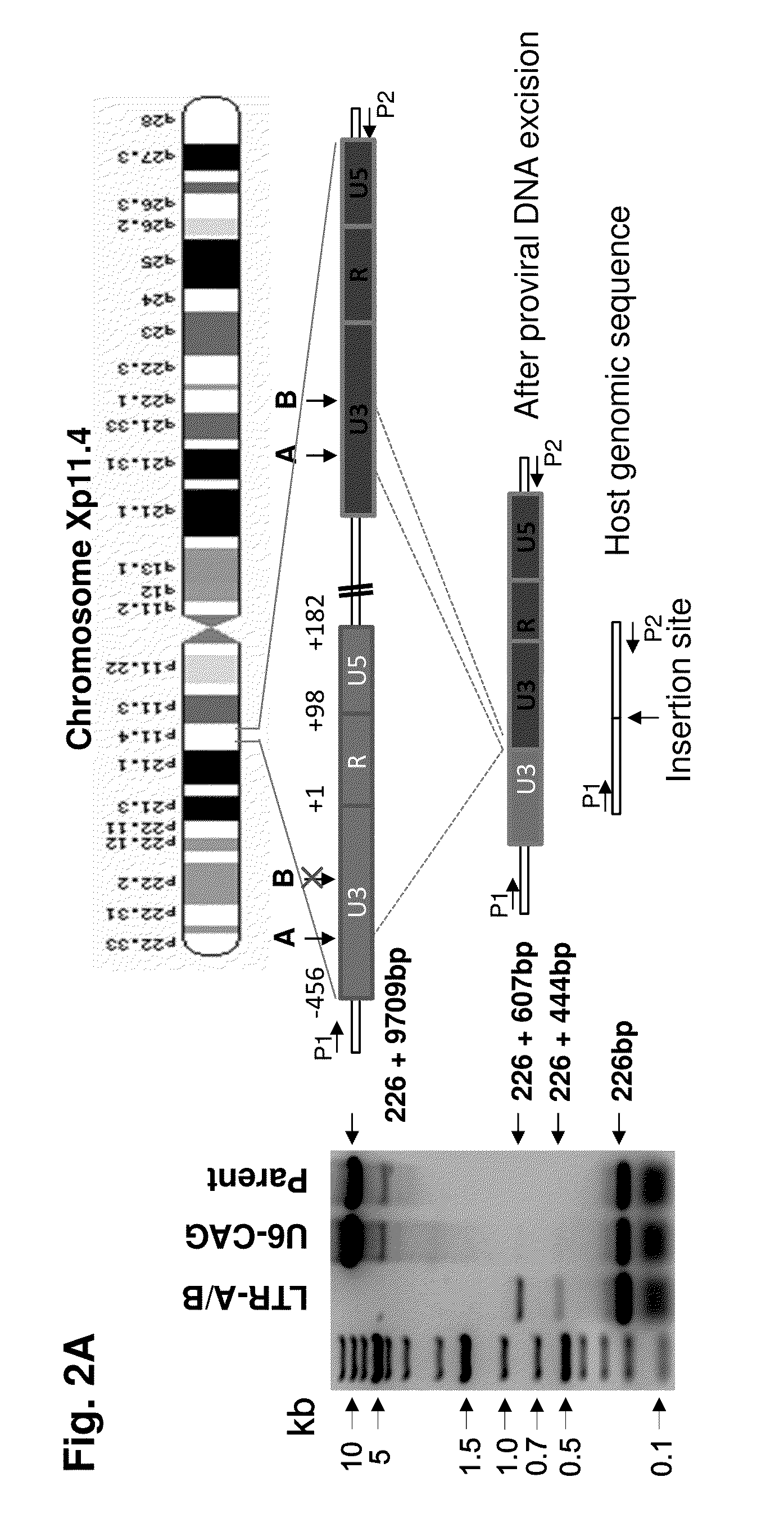Methods and compositions for rna-guided treatment of HIV infection
a technology of rna-guided treatment and compositions, applied in the direction of drug compositions, viruses, enzymology, etc., can solve the problems of failure of haart to suppress low-level viral genome expression and replication in tissues, failure of haart to target latently-infected cells,
- Summary
- Abstract
- Description
- Claims
- Application Information
AI Technical Summary
Benefits of technology
Problems solved by technology
Method used
Image
Examples
example 1
Materials and Methods
[0121]Plasmid Preparation:
[0122]Vectors containing human Cas9 and gRNA expression cassette, pX260, and pX330 (Addgene) were utilized to create various constructs, LTR-A, B, C, and D.
[0123]Cell Culture and Stable Cell Lines:
[0124]TZM-b1 reporter and U1 cell lines were obtained from the NIH AIDS Reagent Program and CHME5 microglial cells are known in the art.
[0125]Immunohistochemistry and Western Blot:
[0126]Standard methods for immunocytochemical observation of the cells and evaluation of protein expression by Western blot were utilized.
[0127]Firefly-Luciferase Assay:
[0128]Cells were lysed 24 h post-treatment using Passive Lysis Buffer (Promega) and assayed with a Luciferase Reporter Gene Assay kit (Promega) according to the manufacturer's protocol. Luciferase activity was normalized to the number of cells determined by a parallel MTT assay (Vybrant, Invitrogen)
[0129]p24 ELISA:
[0130]After infection or reactivation, the levels of HIV-1 viral load in the supernatant...
example 2
Cas9 / LTR-gRNA Suppresses HIV-1 Reporter Virus Production in CHME5 Microglial Cells Latently Infected with HIV-1
[0174]We assessed the ability of HIV-1-directed guide RNAs (gRNAs) to abrogate LTR transcriptional activity and eradicate proviral DNA from the genomes of latently-infected myeloid cells that serve as HIV-1 reservoirs in the brain, a particularly intractable target population. Our strategy was focused on targeting the HIV-1 LTR promoter U3 region. By bioinformatic screening and efficiency / off-target prediction, we identified four gRNA targets (protospacers; LTRs A-D) that avoid conserved transcription factor binding sites, minimizing the likelihood of altering host gene expression (FIGS. 5 and 13). We inserted DNA fragments complementary to gRNAs A-D into a humanized Cas9 expression vector (A / B in pX260; C / D in pX330) and tested their individual and combined abilities to alter the integrated HIV-1 genome activity. We first utilized the microglial cell line CHME5, which harb...
example 3
Cas9 / LTR-gRNA Efficiently Eradicates Latent HIV-1 Virus from U1 Monocytic Cells
[0176]The promonocytic U-937 cell subclone U1, an HIV-1 latency model for infected perivascular macrophages and monocytes, is chronically HIV-1-infected and exhibits low level constitutive viral gene expression and replication. GenomeWalker mapping detected two integrated proviral DNA copies at chromosomes Xp11-4 (FIG. 2A) and 2p21 (FIG. 9A) in U1 cells. A 9935-bp DNA fragment representing the entire 9709-bp proviral HIV-1 DNA plus a flanking 226-bp X-chromosome-derived sequence (FIG. 2A), and a 10176-bp fragment containing 9709-bp HIV-1 genome plus its flanking 2-chromosome-derived 467-bp (FIG. 9A, B) were identified by the long-range PCR analysis of the parental control or empty-vector (U6-CAG) U1 cells. The 226-bp and 467-bp fragments represent the predicted segment from the other copy of chromosome X and 2 respectively, which lacked the integrated proviral DNA. In U1 cells expressing LTR-A / B gRNAs and...
PUM
 Login to View More
Login to View More Abstract
Description
Claims
Application Information
 Login to View More
Login to View More - R&D
- Intellectual Property
- Life Sciences
- Materials
- Tech Scout
- Unparalleled Data Quality
- Higher Quality Content
- 60% Fewer Hallucinations
Browse by: Latest US Patents, China's latest patents, Technical Efficacy Thesaurus, Application Domain, Technology Topic, Popular Technical Reports.
© 2025 PatSnap. All rights reserved.Legal|Privacy policy|Modern Slavery Act Transparency Statement|Sitemap|About US| Contact US: help@patsnap.com



